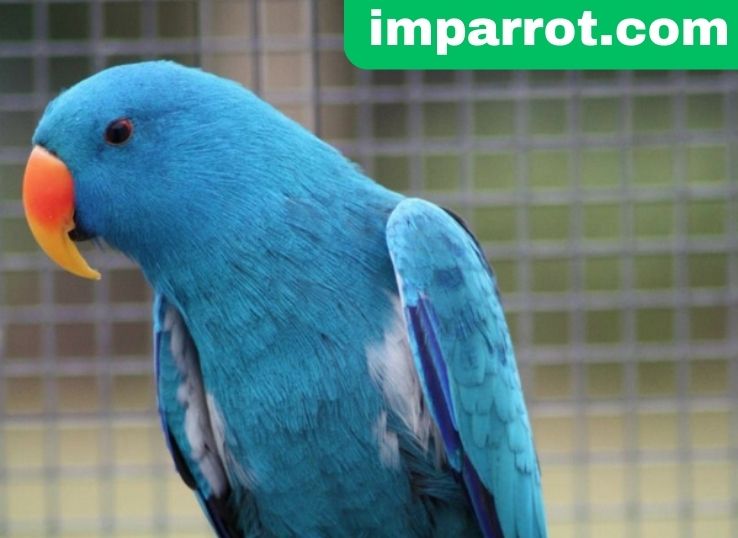Blue Eclectus Parrot (Extremely Rare Eclectus Parrot Mutation)
Last Updated on January 11, 2024 by Ali Shahid
The blue electus parrot is one of the rarest and most desirable mutations of the electus parrot. Blue Eclectus parrots have recessive mutations, which means both males and females carry the blue gene. An Eclectus carrying a single gene will not manifest blue coloration and will be called a split. If you have never seen a Blue Ecletus parrot, you can view the video of Disney The Blue Eclectus. You’ll be blown away by this parrot’s beauty.
These parrots are not only beautiful but also make excellent companions. In addition to being smart, they are decent communicators. They are friendly in captivity but also cope well with independence.
Observing a new color mutation in nature is one thing, but when it occurs in aviculture, it is remarkable. This happens much more frequently than we realize in nature. George Smith’s theory claims that one in six wild creatures in England carries a gene that causes them to exhibit unusual coloration.
Because many bird species are constantly faced with barriers and dangers, mutation-colored birds are the first to be eliminated from their natural populations. As these birds are so obvious, they are most at risk of being killed in the wild. Nevertheless, when conscientious breeders provide food, shelter, and protection, mutant birds aren’t at a disadvantage to predators and can reproduce.
In an aviary setting, breeders can create and popularize new color mutations, which is highly rewarding. Blue Eclectus parrots have an average lifespan of 30-50 years. A single blue eclectus parrot costs $2,700, while a pair costs $5,400. On another website, ParrotStars, blue eclectus are listed for sale for $20,000, though they are currently unavailable.

Origin and History of Blue Eclectus Parrot
According to AFA Watchbird, early in the 1990s, two individuals with a keen interest in Eclectus acquired a cock and a hen from different sources. After pairing up the two birds, they were able to produce their first two chicks.
The cock and hen appear to be normal in appearance. Since these were their first offspring from their breeding pair of Eclectus, they chose to keep them. They were kept in separate aviaries away from their parents.
The owners of that aviary never took down an old nest box that was hanging in the aviary. As soon as the brother and sister pair reached the age of two, mother nature took over and the pair decided to nest and lay two fertile eggs.
When the chicks started feathering, the breeder noticed that one of the birds, a hen, was of a strange color. A blue and gray Eclectus was born in 1995, thus becoming the first blue Eclectus. There have been two additional blues bred since then, including one gorgeous blue cock.
Genetics & Breeding Blue Eclectus Parrot
When discussing the blue mutation in Eclectus parrots, it’s essential to understand its inheritance pattern. This trait follows a recessive pattern, meaning both male and female Eclectus can carry and pass on the blue gene to their offspring.
If both parent birds possess the blue gene and each contributes one blue gene to the offspring, the resulting chick will display the blue coloration.
However, if only one parent carries the blue gene and passes it on to their offspring, the baby Eclectus will appear in its typical coloration. Still, it will carry the blue gene, referred to as being a “split” for the blue mutation.
When planning pairings for breeding, it’s crucial to understand these genetic principles. Depending on the specific pairing of Eclectus parrots, breeders can anticipate a certain percentage of chicks that will exhibit the blue coloration or carry the blue gene as a split.
Here’s a table summarizing the breeding outcomes based on the given pairings of Blue, Split, and Normal Eclectus parrots:
| Parent 1 | Parent 2 | Offspring (%) |
|---|---|---|
| Blue Eclectus | Blue Eclectus | 100% Blue Eclectus (both males and females) |
| Blue Eclectus | Split Eclectus | 50% Blue Eclectus + 50% Split Eclectus (both genders) |
| Blue Eclectus | Normal Eclectus | 100% Split Eclectus (both males and females) |
| Split Eclectus | Split Eclectus | 50% Split Eclectus + 25% Blue Eclectus + 25% Normal Eclectus (all genders) |
| Split Eclectus | Normal Eclectus | 50% Split Eclectus + 50% Normal Eclectus (both genders) |
In other words, you will only be able to produce blue and split babies with the first three combinations. As a result of the 4th combination, 1 in 4 blues can be produced, as well as normals.
However, it is impossible to determine whether they are splits before breeding from them or selling them as possible splits.
Blue Eclectus Parrot Caring
Blue Eclectus parrots should be housed in cages that are 36” long, 24” wide, and 66” high with a maximum wire spacing of 3/4″.
As with other Eclectus species, they require ample amounts of toys and playtime in order to maintain a healthy physical condition. Furthermore, you should also participate in playtime activities.
It will cover the need for emotional stimulation that would otherwise be provided by other flock members in the wild. You may also arrange a bath time for them since they enjoy being sprinkled with water.
Keeping wings clipped is essential since they are prone to flying into fans or outside the house. Make sure not to cut too much, as this can result in pain, stress, and excessive bleeding. Consult an avian vet if you are not familiar with wing and nail clipping.
In terms of diet, they do not require an 80 percent pelleted diet like regular parrots. Since they have a long digestive tract, fruits and vegetables should make up the majority of their diet.
As a veterinarian, I advise my clients to provide 80 percent fruits and vegetables, 15 percent pelleted diets, and 5 percent bird seeds.
From Where You Can Get a Blue Eclectus Parrot
A Blue Eclectus parrot is one of the rarest mutations of the Eclectus species. As a result, these parrots are difficult to find in the market. These blue parrots can only be obtained from specialized breeders who have been breeding them for many years.
Blueeclectus.com, for example, sells a variety of bloodlines of blue Eclectus parrots. In addition, they are able to provide them to individuals outside the United Kingdom for an additional charge of 100 to 200 pounds.
To ensure the safety of their blue babies, they test them for various diseases. To reserve one, you must deposit ten percent of the total cost. There has been no mention of the price, but they are extremely expensive. Normally, a blue Eclectus parrot price is in the range of $3000-$5000.
A second online bird breeder store, Parrotstar.com, has listed blue Solomon Island Eclectus parrots for sale. They have stated that the price is $22,000 dollars (Currently, it is out of stock).
Parrots4homes has also listed a Blue Eclectus Parrot for sale for $2700. It is therefore a very expensive bird and you will require a healthy bank account to purchase a blue Eclectus Parrot.

